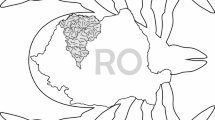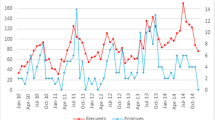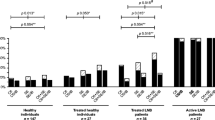Abstract
The purpose of this study was to compare guideline recommendations and day-to-day practice of serological testing for Lyme borreliosis (LB) in a laboratory located in Amsterdam, the Netherlands, serving both regional hospitals and primary care physicians. By telephone interview, we obtained clinical information regarding 488 requests for LB serology. Screening for LB was performed with a C6-peptide EIA and confirmed by recombinant immunoblot. A total of 82 % of the requests were not supported by guideline’s recommendations and either originated from patients with atypical symptoms and a low a priori chance for LB or from patients for which testing on LB was not recommended for other reasons. C6-EIA screening was positive in 5 % of patients with atypical symptoms, comparable to the seroprevalence in the Dutch population. Interestingly, 10 % of the requests were from patients with atypical skin lesions, of which 20 % was positive, suggesting that serological testing is of additional value in a selection of such patients. Strikingly, only 9 % of the requests were supported by recommendations by guidelines. The percentage of positive confirmatory IgM and/or IgG immunoblots did not differ substantially between the groups and ranged from 56 to 75 %. Guidelines for testing for LB are not adequately followed in the Netherlands. Better education and adherence to the guidelines by physicians could prevent unnecessary diagnostics and antibiotic treatment of supposed LB patients.


Similar content being viewed by others
References
Lindgren E, Jaenson TGT (2006) Lyme borreliosis in Europe: influences of climate and climate change, epidemiology, ecology and adaptation measures. http://www.euro.who.int/en/health-topics/environment-and-health/Climate-change/publications/pre-2009/lyme-borreliosis-in-europe.-influences-of-climate-and-climate-change,-epidemiology,-ecology-and-adaptation-measures. Accessed 06 May 2014
Steere AC (1989) Lyme disease. N Engl J Med 321(9):586–596
Strle F, Stanek G (2009) Clinical manifestations and diagnosis of lyme borreliosis. Curr Probl Dermatol 37:51–110. doi:10.1159/000213070
Stanek G, Fingerle V, Hunfeld KP, Jaulhac B, Kaiser R, Krause A, Kristoferitsch W, O’Connell S, Ornstein K, Strle F, Gray J (2011) Lyme borreliosis: clinical case definitions for diagnosis and management in Europe. Clin Microbiol Infect 17(1):69–79. doi:10.1111/j.1469-0691.2010.03175.x
CBO Guideline Lymeziekte. http://www.diliguide.nl/document/1314
Vanousova D, Hercogova J (2008) Lyme borreliosis treatment. Dermatol Ther 21(2):101–109. doi:10.1111/j.1529-8019.2008.00177.x
Flisiak R, Pancewicz S (2008) Diagnostics and treatment of Lyme borreliosis. Recomm Pol Soc Epidemiol Infect Dis Przegl Epidemiol 62(1):193–199
Wormser GP, Dattwyler RJ, Shapiro ED, Halperin JJ, Steere AC, Klempner MS, Krause PJ, Bakken JS, Strle F, Stanek G, Bockenstedt L, Fish D, Dumler JS, Nadelman RB (2006) The clinical assessment, treatment, and prevention of lyme disease, human granulocytic anaplasmosis, and babesiosis: clinical practice guidelines by the Infectious Diseases Society of America. Clin Infect Dis 43(9):1089–1134. doi:10.1086/508667
Steere AC, McHugh G, Damle N, Sikand VK (2008) Prospective study of serologic tests for lyme disease. Clin Infect Dis 47(2):188–195. doi:10.1086/589242
Branda JA, Aguero-Rosenfeld ME, Ferraro MJ, Johnson BJ, Wormser GP, Steere AC (2010) 2-tiered antibody testing for early and late Lyme disease using only an immunoglobulin G blot with the addition of a VlsE band as the second-tier test. Clin Infect Dis 50(1):20–26. doi:10.1086/648674
Liang FT, Steere AC, Marques AR, Johnson BJ, Miller JN, Philipp MT (1999) Sensitive and specific serodiagnosis of Lyme disease by enzyme-linked immunosorbent assay with a peptide based on an immunodominant conserved region of Borrelia burgdorferi vlsE. J Clin Microbiol 37(12):3990–3996
Branda JA, Strle F, Strle K, Sikand N, Ferraro MJ, Steere AC (2013) Performance of United States serologic assays in the diagnosis of Lyme borreliosis acquired in Europe. Clin Infect Dis 57(3):333–340. doi:10.1093/cid/cit235
Wilske B, Fingerle V, Schulte-Spechtel U (2007) Microbiological and serological diagnosis of Lyme borreliosis. FEMS Immunol Med Microbiol 49(1):13–21. doi:10.1111/j.1574-695X.2006.00139.x
Gutierrez J, Guerrero M, Nunez F, Soto MJ, Piedrola G, Maroto MC (2000) Antibodies to Borrelia burgdorferi in European populations. J Clin Lab Anal 14(1):20–26. doi:10.1002/(SICI)1098-2825(2000)14:1
Fahrer H, van der Linden SM, Sauvain MJ, Gern L, Zhioua E, Aeschlimann A (1991) The prevalence and incidence of clinical and asymptomatic Lyme borreliosis in a population at risk. J Infect Dis 163(2):305–310
Carlsson SA, Granlund H, Nyman D, Wahlberg P (1998) IgG seroprevalence of Lyme borreliosis in the population of the Aland Islands in Finland. Scand J Infect Dis 30(5):501–503
Nohlmans MK, van den Bogaard AE, Blaauw AA, van Boven CP (1991) Prevalence of Lyme borreliosis in The Netherlands. Ned Tijdschr Geneeskd 135(48):2288–2292
Lakos A, Reiczigel J, Solymosi N (2010) The positive predictive value of Borrelia burgdorferi serology in the light of symptoms of patients sent to an outpatient service for tick-borne diseases. Inflamm Res 59(11):959–964. doi:10.1007/s00011-010-0209-1
Wilske B (2005) Epidemiology and diagnosis of Lyme borreliosis. Ann Med 37(8):568–579. doi:10.1080/07853890500431934
Strle F, Nadelman RB, Cimperman J, Nowakowski J, Picken RN, Schwartz I, Maraspin V, Aguero-Rosenfeld ME, Varde S, Lotric-Furlan S, Wormser GP (1999) Comparison of culture-confirmed erythema migrans caused by Borrelia burgdorferi sensu stricto in New York State and by Borrelia afzelii in Slovenia. Ann Intern Med 130(1):32–36. doi:10.7326/0003-4819-130-1-199901050-00006
Stanek G, Breier F, Menzinger G, Schaar B, Hafner M, Partsch H (1999) Erythema migrans and serodiagnosis by enzyme immunoassay and immunoblot with three borrelia species. Wien Klin Wochenschr 111(22–23):951–956
Dessau RB, Bangsborg JM, Ejlertsen T, Skarphedinsson S, Schonheyder HC (2010) Utilization of serology for the diagnosis of suspected Lyme borreliosis in Denmark: survey of patients seen in general practice. BMC Infect Dis 10:317. doi:10.1186/1471-2334-10-317
Conflict of interest
The authors declare that they have no conflict of interest.
Author information
Authors and Affiliations
Corresponding author
Rights and permissions
About this article
Cite this article
Coumou, J., Hovius, J.W.R. & van Dam, A.P. Borrelia burgdorferi sensu lato serology in the Netherlands: guidelines versus daily practice. Eur J Clin Microbiol Infect Dis 33, 1803–1808 (2014). https://doi.org/10.1007/s10096-014-2129-4
Received:
Accepted:
Published:
Issue Date:
DOI: https://doi.org/10.1007/s10096-014-2129-4




